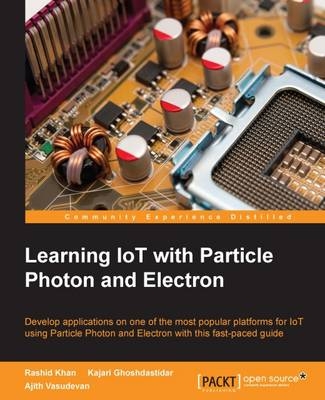
Learning IoT with Particle Photon and Electron
Packt Publishing Limited (Verlag)
978-1-78588-529-7 (ISBN)
About This Book
• Get an introduction to IoT architecture, command-line build tools and applications of IoT devices and sensors
• Design and develop connected IoT applications using Particle Photon and Electron in a step-by-step manner, gaining an entry point into the field of IoT
• Get tips on troubleshooting IoT applications
Who This Book Is For
This book is for developers, IoT enthusiasts and hobbyists who want to enhance their knowledge of IoT machine-to-machine architecture using Particle Photon and Electron, and implement cloud-based IoT projects.
What You Will Learn
• Setup the Particle Photon and Electron on the cloud using the command-line tools
• Build and deploy applications on the Photon and Electron using the Web-based IDE
• Setup a local cloud server to interact with Particle Photon and Electron
• Connect various components and sensors to Particle Photon and Electron
• Tinker with the existing firmware and deploy a custom firmware on the Photon and Electron
• Setup communication between two or more Particle Photon and Electron
• Debug and troubleshoot Particle Photon and Electron projects
• Use webhooks to communicate with various third-party server applications
In Detail
IoT is basically the network of physical devices, vehicles, buildings and other items—embedded with electronics, software, sensors, actuators, and network connectivity that enable these objects to collect and exchange data.. The number of connected devices is growing rapidly and will continue to do so over years to come. By 2020, there will be more than 20 billion connected devices and the ability to program such devices will be in high demand. Particle provides prototyping boards for IoT that are easy to program and deploy. Most importantly, the boards provided by Particle can be connected to the Internet very easily as they include Wi-Fi or a GSM module.
Starting with the basics of programming Particle Photon and Electron, this book will take you through setting up your local servers and running custom firmware, to using the Photon and Electron to program autonomous cars. This book also covers in brief a basic architecture and design of IoT applications. It gives you an overview of the IoT stack. You will also get information on how to debug and troubleshoot Particle Photon and Electron and set up your own debugging framework for any IoT board. Finally, you'll tinker with the firmware of the Photon and Electron by modifying the existing firmware and deploying them to your boards.
By the end of this book, you should have a fairly good understanding of the IoT ecosystem and you should be able to build standalone projects using your own local server or the Particle Cloud Server.
Style and approach
This project-based guide contains easy-to-follow steps to program Particle Photon and Electron. You will learn to build connected applications with the help of projects of increasing complexity, and with each project, a new concept in IoT is taught.
Rashid Khan is a programmer living in Bangalore. He is one of the founders of Yellow Messenger, a company that specializes in building bots for commerce. Prior to founding Yellow Messenger, he worked at EdgeVerve Systems, where he built backend systems to support IoT devices. He is an open source enthusiast and loves to experiment with new technologies. He is involved with a number of open source organizations, such as GNOME, Mono, Tomboy Notes, and Banshee and has built a Django (Python) library for Apache Spark called Django-LibSpark. His interests lie in the field of Artificial Intelligence and interfacing software with real-world objects. Apart from programming, he loves to cycle and play tennis. Kajari Ghoshdastidar got her PhD in wireless sensor networks in 2009 and has been active in IoT-related hobby project work since then. She has worked in the software industry for the last 6 years as a technology architect, software developer, and a computer scientist. She is a technology geek, takes part in hackathons, and is always exploring new technologies and electronic gadgets. She is currently part of the systems engineering team at EdgeVerve, working as a computer scientist. Ajith Vasudevan is an electronics, computer, and IoT enthusiast who likes to apply his knowledge in these fields to make modern living easy for himself and others around him. He has a bachelor's of technology degree in electrical and electronics engineering. He was interested in automation and IoT even before the term IoT became commonplace. He designed and built an automatic overhead-tank motor operator using $1 worth of electronic parts back in 1995, which is operating at his parent's home to this day. He has automated and made it simple and efficient to operate many household appliances, for example, an automatic geyser switch that turns itself off after 10 minutes, saving electricity. It can be set to switch on at any specified time or can be controlled from anywhere. Today, even his friends and neighbors use this system. Ajith has worked in the heavy electrical industry before joining his current employer, Infosys Technologies Limited, in the year 2000. He is presently a senior computer scientist at EdgeVerve Systems, a subsidiary of Infosys. At work, he enjoys programming and has done so for over a decade and a half.
| Erscheinungsdatum | 19.09.2016 |
|---|---|
| Verlagsort | Birmingham |
| Sprache | englisch |
| Maße | 75 x 93 mm |
| Themenwelt | Mathematik / Informatik ► Informatik ► Netzwerke |
| Informatik ► Office Programme ► Outlook | |
| ISBN-10 | 1-78588-529-4 / 1785885294 |
| ISBN-13 | 978-1-78588-529-7 / 9781785885297 |
| Zustand | Neuware |
| Haben Sie eine Frage zum Produkt? |
aus dem Bereich


